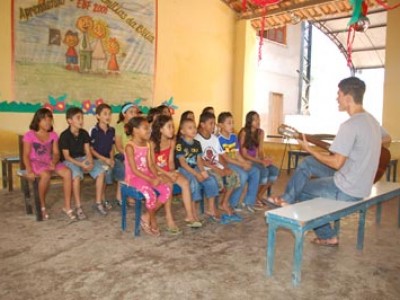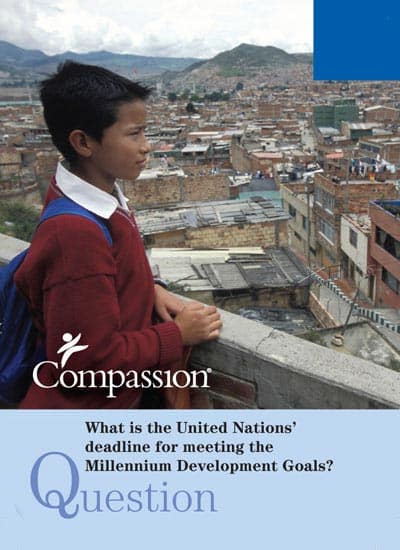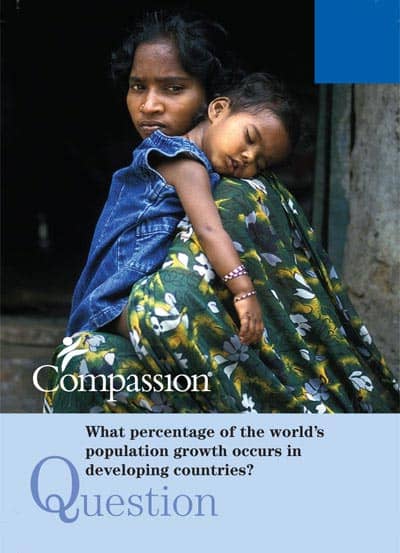God Heals
I’m an American mom who raised two sons, one stepson and one stepdaughter. We were your classic “blended family,” I suppose, and it wasn’t easy. Issues that come up for blended families can be extremely complex.
All four of my children were teenagers at the same time. It was challenging.
I would hear things like, “My dad lets me do … ” or “My mom cooks dinner like … ” It seemed my particular “momming” abilities (for my kids or my stepkids) were never good enough. Consequently, my self-esteem took a beating and I felt unappreciated most of the time.
I have to admit, the years of parenting teens left my heart wounded. The pains of these old wounds have stayed with me. I often wondered if I would ever be released from them.
Then, without expecting it, a special gift from God found its way into my life … all the way from the Dominican Republic. (more…)
Continue Reading ›Perform a Miracle
Now it came to pass, when Jesus finished commanding His twelve disciples, that He departed from there to teach and to preach in their cities. And when John had heard in prison about the works of Christ, he sent two of his disciples and said to Him, “Are You the Coming One, or do we look for another?”
Jesus answered and said to them, “Go and tell John the things which you hear and see: The blind see and the lame walk; the lepers are cleansed and the deaf hear; the dead are raised up and the poor have the gospel preached to them.” — Matthew 11:1-5, NKJV
Jesus, when asked for proof that He is the King of Kings, that He is the promised Savior, responds by listing the miracles He has performed.
The last item Jesus lists in His response to John’s messengers is the one that seems, for me anyway, to stick out the most — “the poor have the gospel preached to them.”
What? Why lump this in with the other things? Surely the poor hearing the gospel can’t be equated with giving sight to the blind or life to the dead?
But Jesus responds to this important question by listing the ways that He has fulfilled the prophecies written about Him.
The Old Testament tells us that the Savior will bring sight to the blind, hearing to the deaf.
The Old Testament tells us that the Messiah will raise the dead and help the lame walk. And it tells us that the Messiah will bring salvation to the poor.
Folks, don’t overlook this important line in Jesus’ answer. It’s not there by mistake. It’s not there as an afterthought.
This is Jesus’ way of telling us that it is divine to bring the gospel to the poor. And it’s the one miracle that we can perform today.
If you think about it, bringing the gospel to the poor IS bringing life to the dead, sight to the blind, hearing to the deaf. This is the miracle that changes lives for eternity!
Continue Reading ›The “Do-Over” Miracle
I’ve been struggling lately with one of Jesus’ miracles. You’re probably familiar with it — it’s in the book of Mark, chapter 8, verses 22-26.
Jesus was in Bethsaida, when a group of people brought a blind man to him. The crowd begged Jesus to touch the man. So Jesus took the man by the hand and led him to a place out of town. There, our Lord spit on the man’s eyes and asked him if he saw anything.
“He looked up and said, ‘I see people; they look like trees walking around.'” – Mark 8:24 (NIV)
So Jesus puts His hands on the man’s eyes a second time … and this time, the man’s sight was restored fully.
Why? Why did it take a “do-over” for Jesus to heal this man? (more…)
Poverty Stops Here
Poverty Questions … and Answers
For the past two weeks we’ve published a series of poverty questions for you to consider. We appreciate everyone who submitted comments to the posts, and we extend our congratulations to Judy Tremblay and her enormous brain for answering the most poverty questions correctly!
Can we get get a “Woot! Woot!” for Judy?
Now, without further ado, here is your answer key.
1. How many children under age 5 die of hunger-related causes every minute?
Six. More than 9 million children under age 5 die every year, and malnutrition accounts for more than one-third of these deaths. Most of these children live in sub-Saharan Africa and South Asia.
(Source: www.unicef.org, November 2008)
2. True or False – One-third of the children in developing countries live in poverty.
True. Of the 1.8 billion children in developing countries, 600 million of them live on less than U.S. $1 a day.
(Source: www.unicef.org/mdg/poverty.html, November 2008)
3. True or False – In reducing the rate of sickness and death from diarrhea, the supply of adequate quantities of water is more important than improving its quality.
True. The organisms that cause diarrhea can be spread through many routes besides drinking water; increased quantities of water can improve household and personal hygiene, which prevents the spread of disease.
Each year about 1.7 million deaths related to dehydration caused by diarrhea occur in children under age 5.
(Sources: www.cdc.gov; http://rehydrate.org/, November 2008)
4. Which one of the following is NOT one of the U.N. Millennium Development Goals?
- Achieve universal primary education
- Ensure environmental stability
- Provide worldwide access to safe water
- Develop a global partnership for development
The answer is provide worldwide access to safe water.
The Millennium Development Goals were created to develop a concrete action plan for the world to reverse poverty, hunger and disease affecting billions of people. The other five goals are:
- Eradicate extreme poverty and hunger
- Promote gender equality and empower women
- Reduce child mortality
- Improve maternal health
- Combat HIV/AIDS, malaria and other diseases
Learn more about the U.N. Millennium Development Goals.
5. True or False – Life expectancy in the world’s poorest countries is about one-third lower than that in the high-income world.
True. Life expectancy in the least developed countries averages 55 years, as compared with 79 years in industrialized countries.
In fact, in most of Africa, average life expectancy is only 50 years.
At any given time, close to half of all people in developing countries suffer from a health problem caused by water and sanitation deficits.
For people in the the developing world, illness, job loss, drought or even pregnancy can mean the difference between life and death.
(Sources: www.unicef.org; www.globalissues.org/article/26/poverty-facts-and-stats, November 2008)
6. What is the definition of extreme poverty?
Living on less than $1 a day. One in six people around the world lives in extreme poverty.
(Sources: www.unicef.org/mdg/poverty.html)
7. Which of the following statements about children in the developing world are true?
- 1 in 3 children does not have adequate shelter.
- 1 in 5 children does not have access to safe water.
- 1 in 7 children does not have access to health care.
- All of the above.
All of the above. Along with malnutrition, these mostly preventable causes are leading contributors to the millions of child deaths each year.
(Source: www.globalissues.org/article/26/poverty-facts-and-stats, November 2008)
8. True or False – The majority of the world’s chronically undernourished people live in Africa.
False. Approximately 790 million people in the developing world are still chronically undernourished, almost two-thirds of whom reside in Asia and the Pacific.
Despite the food production rate being better than the population growth rate, there is still desperate hunger in many parts of the world.
(Sources: World Resources Institute, “Pilot Analysis of Global Ecosystems” (February 2001); www.globalissues.org/article/26/poverty-facts-andstats, November 2008)
9. What percentage of the world’s population growth occurs in developing countries?
95 percent.
Currently, the world’s population totals more than 6.7 billion and grows at an average rate of around 80 million persons per year.
Asia, sub-Saharan Africa and Latin America, three regions of the world made up of mostly developing countries, account for most of the world’s increasing population.
(Sources: www.worldfactbook.org; www.census.gov, November 2008)
10. What is the United Nations’ deadline for meeting the Millennium Development Goals?
2015. The Millennium Project is working with individual countries to help identify and address specific needs, such as access to health clinics, immunizations, teachers, roads and water pumps.
Developed countries have committed to provide increased funding to help reach the Millennium Development Goals by 2015.
(Source: www.undp.org/mdg)

Cherish Family
We cannot do global child development and neglect our own families. God would not be honored if we poured ourselves into the world’s children and neglected our own.
“If anyone does not know how to manage his own family, how can he take care of God’s church?” – 1 Timothy 3:5, NIV
Listen to Mark Hanlon, Senior Vice President of Compassion USA, talk about the importance of cherishing our families.

School for Parents
It is a sunny Sunday morning in San Salvador. It is dry season.
Just as any other Sunday, there are people in the streets coming and going. Housewives with shopping bags going to the local outdoor market to buy the ingredients for lunch, families with their best garments coming from church, and kids going with balls to the park.
The air is filled with freshness and calm, and somehow the future seems brighter for many people going to the local church in the Majucla community.
In a neighborhood named Cuscatancingo, in a poor area of San Salvador, walls full of graffiti, stray dogs, and police and military forces are part of the normal landscape. There are also groups of teenagers with baggy pants and big shirts, some of them with tattoos. They are gang members just ‘chilling.’
In this neighborhood, there is a church named “Tabernaculo Biblico Bautista Majucla” or Baptist Biblical Tabernacle of Majucla. And on this day, at a little bit past 10 in the morning, there are over 100 people in the church.
There is a line outside of the church, and it is growing. The church is almost full. For anybody just passing by, this seems like the second service at the church, but it’s not. The message is a bit different because it is a monthly meeting that the center has with the parents of the children enrolled. (more…)

Best Employee of the Month
As the kitchen door opens, a young man neatly dressed in a chef outfit emerges carrying a bowl of warm spaghetti and wearing a wide smile of self-confidence. Although he began cooking only six months before, he carries himself like an experienced cook.
“After finishing high school, I was not sure what career to choose, so I decided to write down all the things I like best and found out that the best option for me is tourism and hotel administration,” says Waldo, a 21-year old Leadership Development Program student who is breaking the cycle of poverty by studying at a university in Lima City.

The Sound of Gratitude
At the age of 3, John had his first contact with music. It was at a Compassion child development center.
Everything in John’s life could be dissonant if a particular day in his past hadn’t happened. Now, like in a beautiful symphony, John is conducting his life in a new tone – the tone of leadership.
John was 12 when everything happened. It seemed to be the last straw when the director of his former child center called his name and said, “I want to see you in my office now.”
Frightened, John walked to the place so familiar to him because of his aggressiveness and disobedience. But this was a day he didn’t do anything wrong. So he thought, “It’s done. There is no way out.”
He was right. For sure there was not. (more…)





